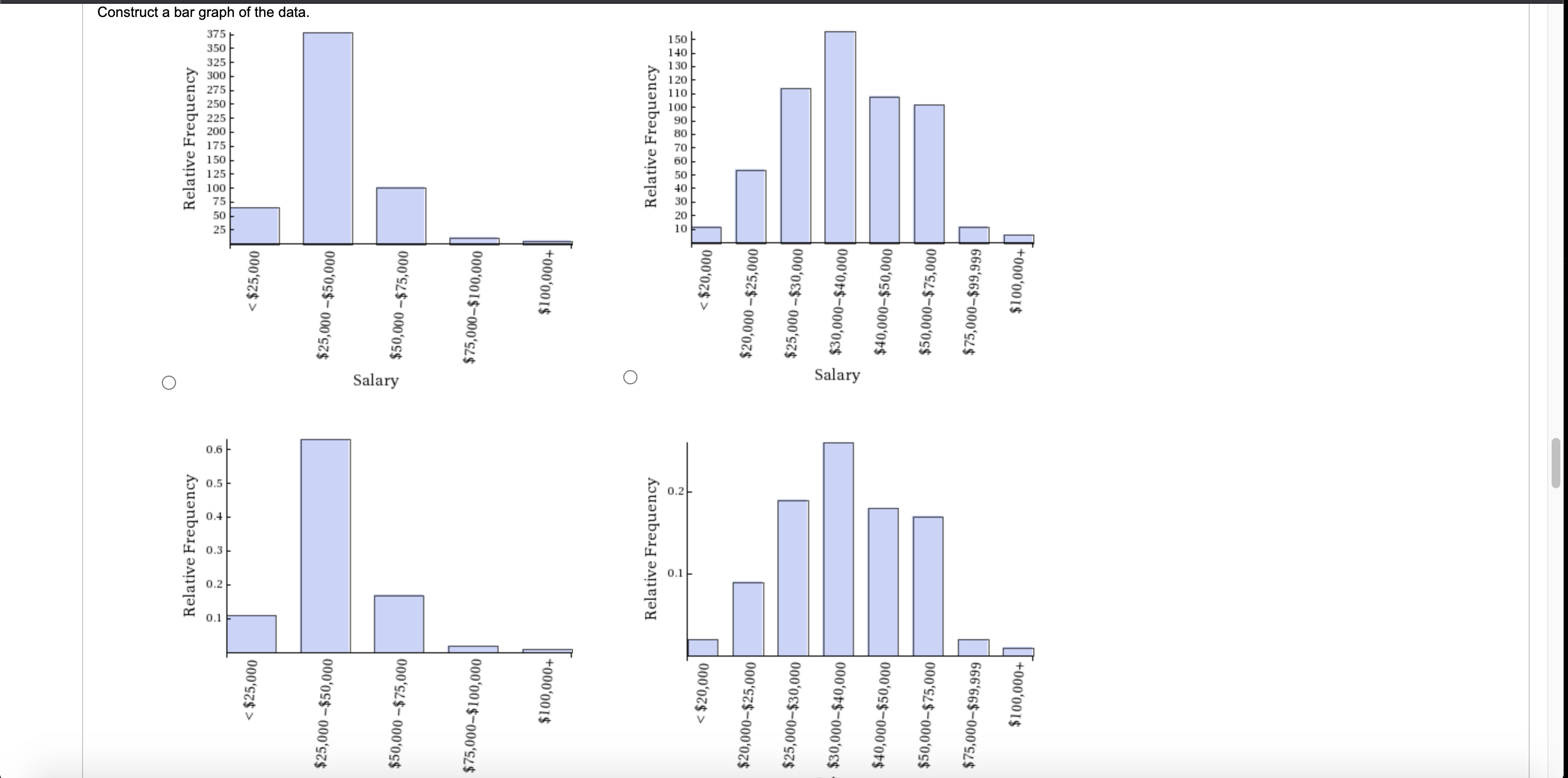Six hundred adult Americans were asked by telephone poll, "What do you think constitutes a middle-class income?" The results are in the table below. Also, include left endpoint, but not the right endpoint. Salary ($) Relative Frequency <20,000 0.02 20,000–25,000 0.09 25,000–30,000 0.19 30,000–40,000 0.26 40,000–50,000 0.18 50,000–75,000 0.17 75,000–99,999 0.02 100,000+ 0.01 Part (a) What proportion of the survey answered "not sure"? (Enter your answer to two decimal places.) Part (b) What proportion think that middle-class is from $20,000 to $40,000? (Enter your answer to two decimal places.) Part (c) Construct a histogram of the data. (i) Should all bars have the same width, based on the data? Why or why not? 1. Yes, because the bars of histograms should always have the same width. 2.No, because the data is organized into categories with different widths. (ii) How should the <20,000 and the 100,000+ intervals be handled? Why? 1.They should be excluded because they introduce too much skew. 2.The <20,000 interval will be part of an interval starting at $0, since salaries can't go below $0. The 100,000+ interval will not be changed. Part (d) In what interval will the 40th percentile fall? < $20,000$20,000 - $25,000 $25,000 - $30,000$30,000 - $40,000$40,000 - $50,000$50,000 - $75,000$75,000 - $99,999$100,000+ In what interval will the 80th percentile fall? < $20,000$20,000 - $25,000 $25,000 - $30,000$30,000 - $40,000$40,000 - $50,000$50,000 - $75,000$75,000 - $99,999$100,000+ Part (e) Construct a bar graph of the data.
Six hundred adult Americans were asked by telephone poll, "What do you think constitutes a middle-class income?" The results are in the table below. Also, include left endpoint, but not the right endpoint. Salary ($) Relative Frequency <20,000 0.02 20,000–25,000 0.09 25,000–30,000 0.19 30,000–40,000 0.26 40,000–50,000 0.18 50,000–75,000 0.17 75,000–99,999 0.02 100,000+ 0.01 Part (a) What proportion of the survey answered "not sure"? (Enter your answer to two decimal places.) Part (b) What proportion think that middle-class is from $20,000 to $40,000? (Enter your answer to two decimal places.) Part (c) Construct a histogram of the data. (i) Should all bars have the same width, based on the data? Why or why not? 1. Yes, because the bars of histograms should always have the same width. 2.No, because the data is organized into categories with different widths. (ii) How should the <20,000 and the 100,000+ intervals be handled? Why? 1.They should be excluded because they introduce too much skew. 2.The <20,000 interval will be part of an interval starting at $0, since salaries can't go below $0. The 100,000+ interval will not be changed. Part (d) In what interval will the 40th percentile fall? < $20,000$20,000 - $25,000 $25,000 - $30,000$30,000 - $40,000$40,000 - $50,000$50,000 - $75,000$75,000 - $99,999$100,000+ In what interval will the 80th percentile fall? < $20,000$20,000 - $25,000 $25,000 - $30,000$30,000 - $40,000$40,000 - $50,000$50,000 - $75,000$75,000 - $99,999$100,000+ Part (e) Construct a bar graph of the data.
Glencoe Algebra 1, Student Edition, 9780079039897, 0079039898, 2018
18th Edition
ISBN:9780079039897
Author:Carter
Publisher:Carter
Chapter10: Statistics
Section10.4: Distributions Of Data
Problem 19PFA
Related questions
Question
Six hundred adult Americans were asked by telephone poll, "What do you think constitutes a middle-class income?" The results are in the table below. Also, include left endpoint, but not the right endpoint.
| Salary ($) | Relative Frequency |
|---|---|
| <20,000 | 0.02 |
| 20,000–25,000 | 0.09 |
| 25,000–30,000 | 0.19 |
| 30,000–40,000 | 0.26 |
| 40,000–50,000 | 0.18 |
| 50,000–75,000 | 0.17 |
| 75,000–99,999 | 0.02 |
| 100,000+ | 0.01 |
-
Part (a)
What proportion of the survey answered "not sure"? (Enter your answer to two decimal places.) -
Part (b)
What proportion think that middle-class is from $20,000 to $40,000? (Enter your answer to two decimal places.) -
Part (c)
Construct a histogram of the data.(i) Should all bars have the same width, based on the data? Why or why not?
1. Yes, because the bars of histograms should always have the same width.2.No, because the data is organized into categories with different widths.
(ii) How should the <20,000 and the 100,000+ intervals be handled? Why?
1.They should be excluded because they introduce too much skew.2.The <20,000 interval will be part of an interval starting at $0, since salaries can't go below $0. The 100,000+ interval will not be changed.
-
Part (d)
In what interval will the 40th percentile fall?
< $20,000$20,000 - $25,000 $25,000 - $30,000$30,000 - $40,000$40,000 - $50,000$50,000 - $75,000$75,000 - $99,999$100,000+
In what interval will the 80th percentile fall?
< $20,000$20,000 - $25,000 $25,000 - $30,000$30,000 - $40,000$40,000 - $50,000$50,000 - $75,000$75,000 - $99,999$100,000+ -
Part (e)
Construct a bar graph of the data.

Expert Solution
This question has been solved!
Explore an expertly crafted, step-by-step solution for a thorough understanding of key concepts.
This is a popular solution!
Trending now
This is a popular solution!
Step by step
Solved in 4 steps with 4 images

Knowledge Booster
Learn more about
Need a deep-dive on the concept behind this application? Look no further. Learn more about this topic, statistics and related others by exploring similar questions and additional content below.Recommended textbooks for you

Glencoe Algebra 1, Student Edition, 9780079039897…
Algebra
ISBN:
9780079039897
Author:
Carter
Publisher:
McGraw Hill

Holt Mcdougal Larson Pre-algebra: Student Edition…
Algebra
ISBN:
9780547587776
Author:
HOLT MCDOUGAL
Publisher:
HOLT MCDOUGAL

Glencoe Algebra 1, Student Edition, 9780079039897…
Algebra
ISBN:
9780079039897
Author:
Carter
Publisher:
McGraw Hill

Holt Mcdougal Larson Pre-algebra: Student Edition…
Algebra
ISBN:
9780547587776
Author:
HOLT MCDOUGAL
Publisher:
HOLT MCDOUGAL